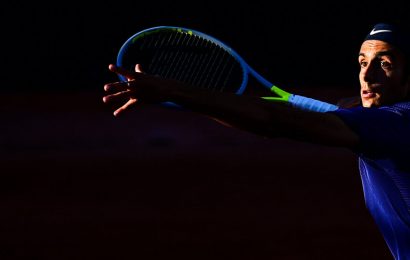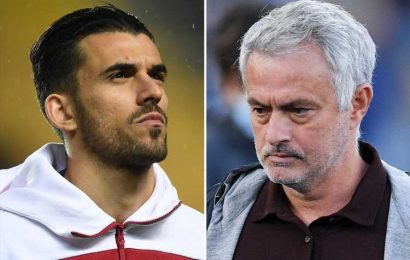Mikaela Shiffrin, who became the most successful ski racer in Alpine World Cup history with a record-setting 87th victory, winning her slalom race on Saturday in Are, Sweden, works out from April to October at a colossal gym inside the Westin hotel near her home in Edwards, Colo.
Entering the facility in the mountains, visitors come upon a sprawling tribute to Shiffrin celebrating some of her nine Olympic and world championship gold medals. One day at the gym last fall, as a family took snapshots next to Shiffrin’s image, she walked past unobserved.
Did Shiffrin consider asking her fans if they would prefer a photograph with her in person? Looking embarrassed, she said: “Oh, no. I don’t want to bother them.”
When athletes pass milestones that have stood for decades, and Shiffrin, 27, has eclipsed Ingemar Stenmark’s 1989 record with several prime years left in her career, one wonders: Beyond raw talent, how did they do it? Shiffrin managed to avoid four common pitfalls — ego, injury, complacency and outside distractions — that have derailed others, even ruined careers. Their absence has had a distinct role in Shiffrin’s uncommon success.
As the anecdote from the entryway to Shiffrin’s Colorado gym illustrates, a pernicious ego is not her problem. Which leaves:
Injury
In elite ski racing, an occasional fall on the icy snow between the gates is unavoidable. If a bone-breaking, high-speed crash does not wreck a promising career, then chronic injuries, especially to the lower back and knees, typically persist because of the enormous forces racers absorb to execute precise turns at 60 to 80 miles per hour. Lingering infirmities, and the surgeries needed to blunt them, can interrupt and end careers. In this century, virtually no prominent racer, be it the Americans Bode Miller and Lindsey Vonn or Janica Kostelic of Croatia, has escaped severe injuries. Austria’s Marcel Hirscher, fourth on the career World Cup wins list, was once considered the most fortunate skier of the modern era because he broke only two leg bones.
Then there is Shiffrin, whose only serious injury has been a torn medial collateral ligament in a knee in 2015 that cost her two months of racing. And even that injury was a freakish occurrence that might never have happened if Eileen Shiffrin, Mikaela’s mother and her primary coach, had been on the mountain that day. (More on that later.)
But first, it’s important to understand that Shiffrin’s unrivaled durability is primarily a reflection of a singular precision mixed with noteworthy premeditation.
“Avoiding injuries is at least 80 percent skill,” said Ted Ligety, the retired skier who won five world championships and is the only American man with two Alpine Olympic gold medals. “People who fall generally do it a lot because they take too many risks and don’t have the technical skills to get out of trouble they get into.”
He added: “The one thing Mikaela has in excess is technical skills. She doesn’t put herself in risky positions and when she makes a rare mistake she’s so good technically she escapes without a bad fall.”
Eileen Shiffrin, who has coached and traveled with Mikaela since her debut on the World Cup circuit at 15, credits her daughter’s largely injury-free career to a trait not usually associated with ski racers: caution.
“She rarely skis at 100 percent of what she’s capable of doing, more like 80 percent,” Eileen said in a telephone interview from Switzerland last month. “She’s very calculated that way and always has been.”
Or as Mikaela said in a separate interview: “I never want to be surprised on skis,” — part of the lore of her only significant injury as a professional.
Eileen, a former high-level ski racer whose full-time profession was an intensive care nurse, never intended to be one of her daughter’s coaches forever, especially since Mikaela always had United States ski team coaches and trainers at her side. So in late 2015, Eileen stepped away from her coaching duties.
While preparing for the first race without her mother, Mikaela took a casual run next to a training course in Sweden and fell hard, crashing into the protective netting at the trail’s edge. The damage to a right knee ligament required only rest, but the details of the mishap stood out: the trail Mikaela skied that day had windblown snow, far different than the conditions of a prepared course.
“Mikaela thought that if I had been there I would have warned her to be more careful,” Eileen said.
Returning to Europe with her mother two months later, Mikaela won her first race back and then two more to finish the season with five victories.
By late 2019, Eileen again tried semiretirement. Within weeks, Mikaela’s skiing was deteriorating, including a jarring 17th-place finish. When Eileen rejoined the coaching staff, Mikaela won her next two races and was on the podium for seven of the season’s final 10 events. Since then, mother and daughter have remained a team.
Said Mikaela: “People are always asking me, ‘What’s your secret?’ I want to say: ‘Isn’t it obvious? It’s my mom.’”
Complacency
Athletes can become bored after decades of routine, and some will say nothing becomes more wearisome than the essential ritual of practice. But Shiffrin much prefers practice to competing, which she finds stressful. Her idea of a perfect day is 10 (or 15) uninterrupted training runs through a racecourse.
A few years ago, after Shiffrin had finished second in the first of two World Cup races in Killington, Vt. — a day that started with course inspections at dawn — she was whisked to another part of the resort where her coaches had set up a training course at her request. Shiffrin powered through run after run until the sun began to set. She disappeared in the gloaming, but you could hear the gates clicking as she passed.
“One more run?” Shiffrin begged.
“It’s dark, Mikaela,” a coach replied. “We have to go.”
Shiffrin won the next day’s race by nearly two seconds, a prodigious margin of victory in a ski race.
“Mikaela never tires of process, of finding solutions to tactical challenges,” said Paul Kristofic, the veteran head coach of the U.S. women’s ski team.
It is an approach instilled in Shiffrin by her mother and father, Jeff Shiffrin, a former collegiate ski racer. When Mikaela was a youth racer, her parents eschewed the common practice of entering multiple junior races every month.
Instead, Shiffrin stayed at her home hill where she would get in numerous practice runs rather than two isolated runs at a faraway race, a choice that stressed skill development over setting performance-based goals. Still, when she did race, Mikaela won big and her renown spread nationally. But the Shiffrins evangelized normalcy.
“These top-level coaches would tell me that Mikaela was just ripping up a racecourse,” Jeff Shiffrin said in 2013 as he sat in his Colorado home. “And I would say: ‘Yeah, I agree, but she’s just 9 years old.’ And they’d say, ‘What are your plans for her?’
“And I’d answer: ‘Plans? Well, tomorrow she’s trying out for a part as an angel in the school Christmas play.’”
Outside Distractions
In Mikaela’s first nine years on the World Cup circuit, her life off the snow was without any meaningful complications. That changed on Feb. 1, 2020, when her older brother, Taylor, reached her by phone in Europe to say that their father had been seriously hurt in an accident at home in Colorado. Returning to Denver, Mikaela and Eileen and other family members were at Jeff’s bedside in the hours before his death on Feb. 2.
The family has declined to reveal details of the accident; a coroner listed the cause of death as a head injury.
Mikaela stopped competing for nine months. When she rejoined the World Cup, she continued to win races but found that even good results could be upsetting.
“I’m pretty sad,” she said after one victory because it reminded her that she would never again call her father after a race.
The 2022 Beijing Olympics brought baffling performances. Favored to win multiple medals, she fell three times and won none. But in the aftermath of those Games, Shiffrin rallied to win the 2022 World Cup overall title and the 2023 season saw her swiftly — almost astonishingly — accelerate toward the career World Cup win record and a fifth World Cup overall title.
“The past couple of years have been difficult times but we managed to make our way through it and survive that,” Eileen Shiffrin said. “I think we’ve come out the other side of that closer than ever and more functional as well.”
Family tragedy, of course, is not the only way that the personal lives of elite athletes can interrupt or alter an auspicious career. Outside problems of all kinds intercede, from an overzealous nightlife to tangled relationships to money woes.
But since Mikaela was a child, it has been hard for her to divert her eyes from the snow beneath her skis. When she turned 18, I recall asking her if she was now going to bars.
“I can go out and be more social,” she answered. “But I want to be home by 9:30 to 10. I can’t function unless I get a minimum of eight hours of sleep.”
She does binge watch her favorite television shows. In 2017, she said with a laugh: “The most exciting thing of my week might be when the new ‘Madam Secretary’ episode comes out.”
And she has learned to take time to celebrate major accomplishments, like her 14 world championship medals, something the tennis star Roger Federer encouraged her to do when hosting her for lunch last year at his home in Switzerland.
For two years, Shiffrin has been dating the Norwegian skier Aleksander Aamodt Kilde, a two-time Olympic medalist. They are ski racing’s power couple, with self-imposed curfews.
“A healthy distraction,” Eileen called the relationship.
“We talk every night,” Mikaela said, “but we say good night early because there’s so much to do the next day.” Beach vacations will wait until late spring.
Last fall, at the gym near her home, which sits in the middle of a Colorado snow sports kingdom, Shiffrin pedaled on a stationary bike for nearly an hour unbothered. When finished, with a towel around her neck, she headed for the exit.
In the hallway, a crowd clustered in front of the photo tribute to her. Cellphone cameras were held aloft.
Turning sideways as she threaded her way through the group, the ski racer on the precipice of setting the record for most World Cup race victories turned to look over her shoulder and smiled.
Source: Read Full Article







